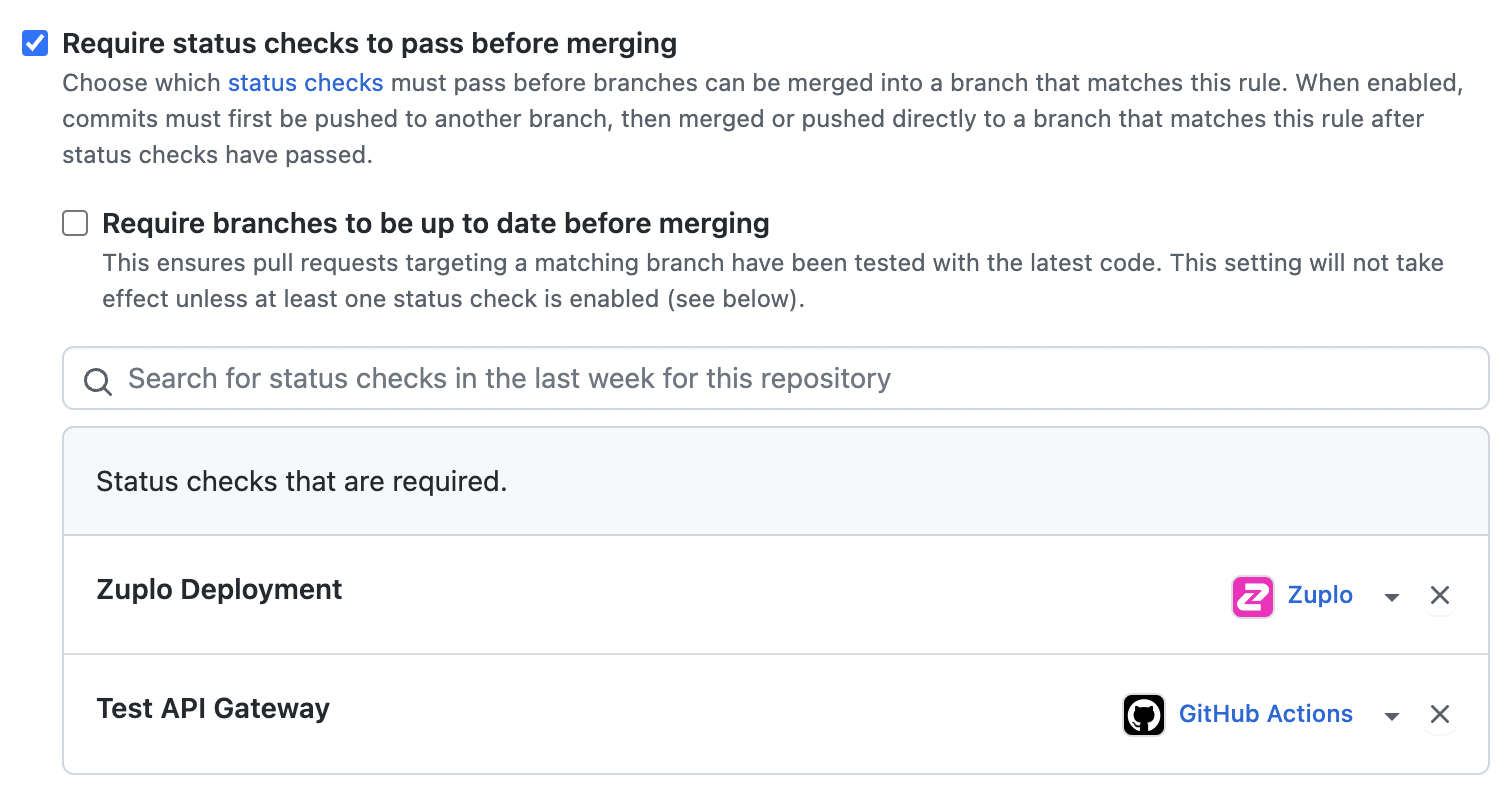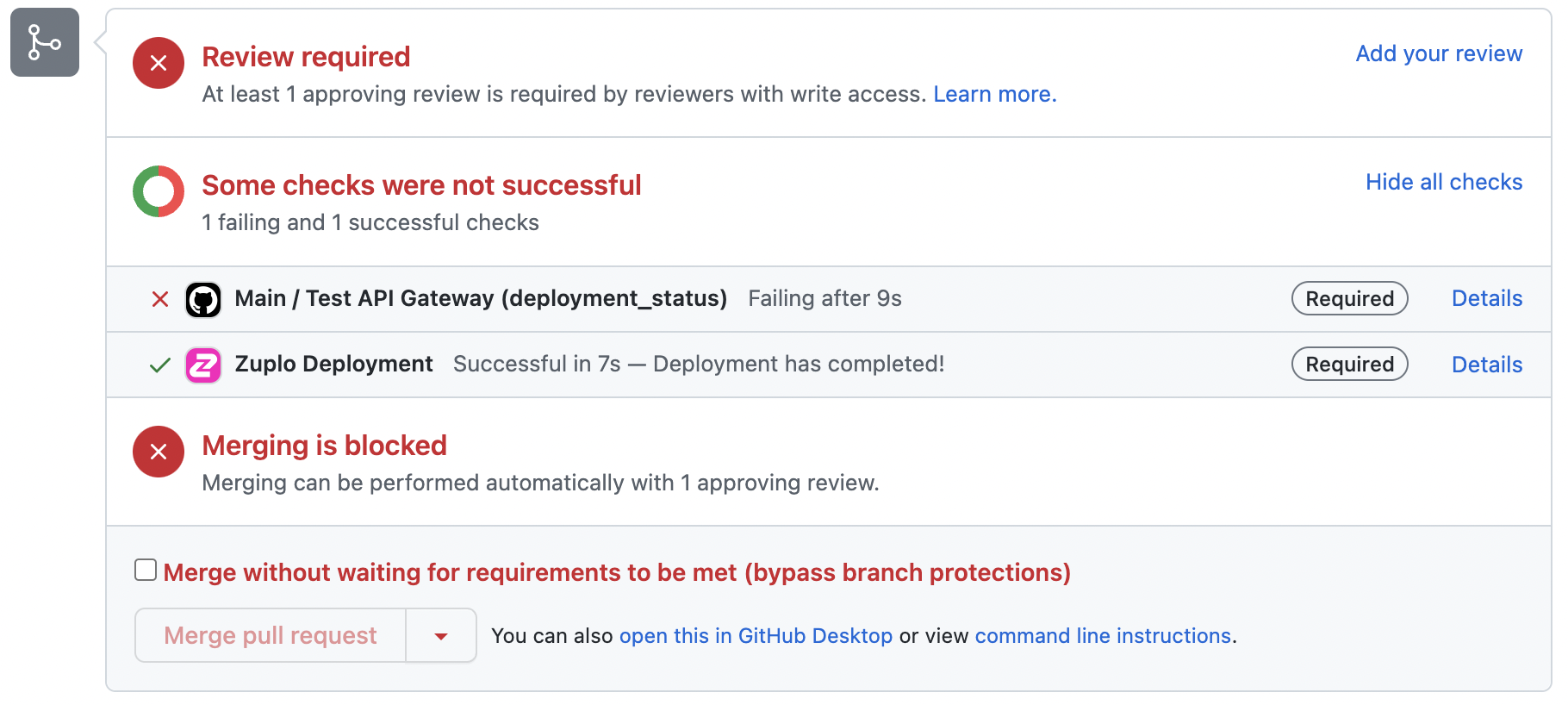Getting to Production
Testing
These instructions assume that you are using custom GitHub Action workflow, in conjunction with the Zuplo deployer. If you prefer setting up your own CI/CD for more fine-grained control, please take a look at running your own CI/CD.
Using the Zuplo GitHub integration, tests can be run after a deployment with the Zuplo deployer and used to block pull requests from being merged. This can help ensure that changes to your Zuplo gateway won't break your production environment.
The Zuplo deployer sets Deployments and Deployment Statuses for any push to a GitHub branch.
Here is a simple GitHub Action that uses the Zuplo CLI to run the tests after
the deployment is successful. Notice how the property
github.event.deployment_status.environment_url is set to the API_URL
environment variable. This is one way you can pass the URL where the preview
environment is deployed into your tests.
name: Main
on: [deployment_status]
jobs:
test:
name: Test API Gateway
runs-on: ubuntu-latest
steps:
- uses: actions/checkout@v3
- name: Use Node.js
uses: actions/setup-node@v3
with:
node-version: 18.x
- name: Run Tests
# Useful properties 'environment', 'state', and 'environment_url'
run:
API_URL=${{ toJson(github.event.deployment_status.environment_url) }}
npx @zuplo/cli test --endpoint $API_URLGitHub Branch protection can be set in order to enforce policies on when a Pull Request can be merged. The example below sets the "Zuplo Deployment" and "Test API Gateway" as required status that must pass.

When a developer tries to merge their pull request, they will see that the tests haven't passed and the pull request cannot be merged.

Writing Tests#
Using Node.js 18 and the Zuplo CLI, it is very easy to write tests that make
requests to your API using fetch and then validate expectations with expect
from chai.
import { describe, it, TestHelper } from "@zuplo/test";
import { expect } from "chai";
describe("API", () => {
it("should have a body", async () => {
const response = await fetch(TestHelper.TEST_URL);
const result = await response.text();
expect(result).to.equal(JSON.stringify("What zup?"));
});
});You can find more sample tests here.
Your test files need to be under the tests folder and end with .test.ts to
be picked up by the Zuplo CLI.
Tips for writing tests#
This section highlights some of the features of the Zuplo CLI that can help you write and structure your tests. You can find more sample tests here.
Ignoring tests#
You can use .ignore and .only to ignore or run only specific test. The full
example is at
ignore-only.test.ts
import { describe, it } from "@zuplo/test";
import { expect } from "chai";
/**
* This example how to use ignore and only.
*/
describe("Ignore and only test example", () => {
it.ignore("This is a failing test but it's been ignored", () => {
expect(1 + 4).to.equals(6);
});
// it.only("This is the only test that would run if it were not commented out", () => {
// expect(1 + 4).to.equals(5);
// });
});Filtering tests#
You can use the CLI to filter tests by name or regex. The full example is at filter.test.ts
import { describe, it } from "@zuplo/test";
import { expect } from "chai";
/**
* This example shows how to filter the test by the name in the describe() function.
* You can run `zup test --filter '#labelA'`
* If you want to use regex, you can do `zup test --filter '/#label[Aa]/'`
*/
describe("[#labelA #labelB] Addition", () => {
it("should add positive numbers", () => {
expect(1 + 4).to.equals(5);
});
});Unit Tests & Mocking#
Custom testing can be complicated and is best used only to test your own logic rather than trying to mock large portions of your API Gateway.
It is usually possible to use test frameworks like Mocha and mocking tools like Sinon to unit tests handlers, policies, or other modules. To see an example of how that works see this sample on Github: https://github.com/zuplo-samples/test-mocks